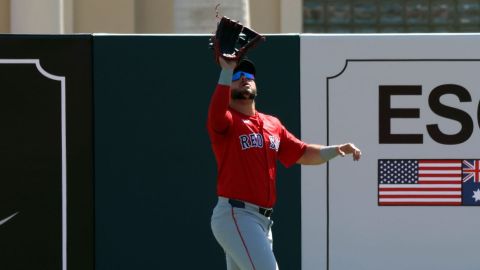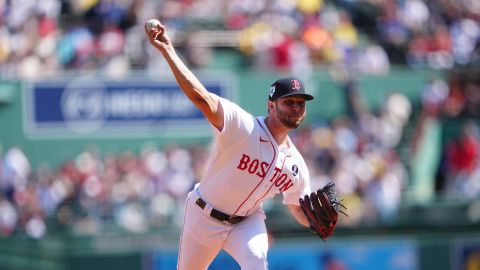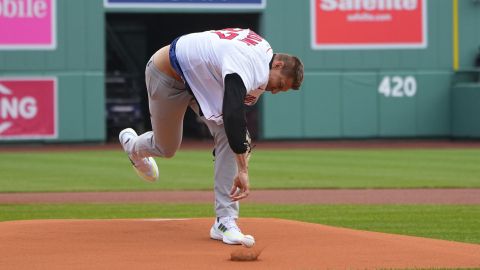Rick Peterson may be one of the most well-known pitching coaches who has worked in baseball. Peterson has coached in the majors for the Chicago White Sox, Toronto Blue Jays and New York Mets. He is probably best known for his time as the pitching coach of the Oakland A’s from 1998 to 2003. There, he coached a pitching staff featuring the “Big Three” of Mark Mulder, Tim Hudson and Barry Zito to the American League’s best ERA in 2002 and 2003.
Peterson sat down with NESN Nation to share his thoughts on the Red Sox’ starting rotation, the upcoming Moneyball movie starring his Oakland A’s, and how Jon Lester might be able to avoid some early-inning woes.
NESN Nation: Some people think the Red Sox might consider a six-man rotation to keep Andrew Miller and Tim Wakefield both in the rotation once Clay Buchholz gets healthy. Is that a good idea?
Rick Peterson: One of the things you have to look at when you think about a six-man rotation is every pitching coach has their philosophy. Mine in particular was, before we left to go to spring training, I had mapped out probably four or five different schedules all the way to the All-Star break.
What you want to make sure of is that your number one starter– this year being [Josh] Beckett— should get at least 19 starts before the All-Star break. Your number two guy, maybe a start less. So when you’re looking at if you put in a sixth guy, you don’t want to lose a start from Beckett and Lester. That would be horrific, because they’re your two best guys. So you want to make sure that Beckett gets at least 19 starts and Lester gets maybe 19, but he’ll get a minimum of 18. But if you bump Beckett down to 18 or 17, and Lester down to 17 or 16, you can never recoup those starts in the second half of the season.
So from that standpoint, you may go to a six-man rotation, but you’re not going to lose Beckett’s and Lester’s starts. You might give them a fifth day’s rest on occassion, but you’re not going to lose their starts. You want to make sure that you when you plug those other guys into the rotation, you’re plugging in Beckett and Lester all the way to the All-Star break, and then if you want to go with six guys, you’re plugging the other four guys in [on the other days].
Then, you can start looking at matchups. You can look at different clubs against left-handed pitching, for Miller, and how good they are against right-handed pitching, for [Alfredo] Aceves. And then Wakefield, maybe you look at the weather report and see what’s the optimal weather. If they’ve got crosswinds that day, then maybe you give him the extra day, so that he’s got headwinds when he starts.
NESN Nation: You spent some time with the A’s coaching their “Big Three” of Mark Mulder, Tim Hudson and Barry Zito. After your arrival, the team led the American League in ERA for two years, and all three guys were 20-game winners. How do you think those guys match up to the Red Sox rotation this year?
RP: I think with Dasiuke [Matsuzaka] out, that’s a big blow. But with [Clay] Buchholz healthy, and with the kind of year Beckett is having, I think you’re looking at some parallels. I don’t know if Lester’s the best lefty right now in baseball — I mean [Cole] Hamels is pretty good, David Price is pretty good– but he’s certainly one of the best lefties in the game. And having a young pitcher there in Buchholz, you got two young guys. With Beckett, it’s a case of being healthy. I know he’s had some back problems over the years, but with Beckett healthy, look at what he’s doing this year. He’s looked absolutely phenomenal.
NESN Nation: Now, that A’s team is being brought to the big screen in the upcoming movie Moneyball, with Brad Pitt starring as Billy Beane. How excited are you for the movie to come out?
RP: I’m really excited. When the project first broke in 2009, Steven Soderbergh was originally the director. And Steven called me and offered me the opportunity to one, be the technical director and two, play myself in the movie. So I spent five months with Steven Soderbergh as the technical director of the movie and preparing to play myself.
There were about 20 of us preparing to play ourselves: players, scouts, some front office people. And I thought that was an incredibly exciting project. When people were saying, “Rick, what are you doing while taking a year off after leaving the Mets?” And I said, “Well, I dunno. Maybe I’ll do a movie with Brad Pitt and Steven Soderbergh?” [Laughs.]
So what happened was, the day before they were going to start shooting, Sony pushed the pause button and let Steven Soderbergh go, along with all of us, and brought in a new director [Bennett Miller]. Since then, I haven’t really followed anything. A couple of my friends have told me the movie’s coming out sometime early in the fall [the movie comes out Sept. 23]. But I’m anxious to see it, especially after living those years.
When I look back on the Moneyball years, there are so many people’s careers that were launched — players, front office people, coaches — during that year. That was a special group of people that came together to do some really special things.
NESN Nation: You’ve worked pretty closely with Dr. James Andrews, a name many baseball fans will recognize for his notoriety performing surgery on many top athletes. What did you learn from him that you were able to use as a pitching coach?
RP: Well, I happened to be the Double-A pitching coach in Birmingham in 1989, when Dr. Andrews opened the ASMI lab. I was the first guy to walk in those doors. And from that point on, my career totally changed.
I’ve used the paradigm of biomechanical analysis as the foundation of my pitching program. And because of that, the big question was: How do we get the lab to the pitcher? We finally found the technology that you can get a Little League pitcher, all the way to a big league pitcher, on their field, upload it to a website, and you’ll get 14 measurements as if you flew to Birmingham.
What’s amazing about Dr. Andrews’ research is that when you look at Major League Baseball in the last decade, just about $1.2 billion has been spent on pitching salaries. Close to $400 million of it has been spent on injured pitchers. That’s close to 30 percent of the total payroll.
Can you imagine if Apple turned out all their iPhones and iPads, and 30 percent of them were damaged? Steve Jobs would lose his mind.
And in the amateur market in the last decade, there’s been a 700 percent increase in Tommy John surgeries. It’s an epidemic. If that was actually a disease, the federal government would allocate funding to find a cure for it. So the biomechanical analysis [that Dr. Andrews and I use] is really the core foundation to keep healthy pitchers healthy.
NESN Nation: Jon Lester has struggled in the early innings for the Red Sox this season. What kinds of things could he think about adjusting in his routine to avoid the early-inning woes?
RP: We’ve done two things which have been really successful for starting pitchers.
First, you have a home start and a road start. So let’s say the game starts at 7:05. Typically, at home, the starting pitcher will leave the bullpen at seven o’clock. One of the top things you can do is start your warm-up routine five minutes earlier. Then you stop it with another 10 to 15 pitches to go, sit down for five minutes, and then rehearse the first inning. Take your eight warm-up pitches and then face the first two guys in that lineup.
Typically, what will happen is that the starting pitcher will warm up, and then he’ll walk into the dugout and sit down, and that’s the first time he’s sat down. It’s his first adjustment. And if he goes up and he’s struggling in the game, this allows him to make one more adjustment in the bullpen.
The other big factor is pitching on the road. Most stadiums, Fenway isn’t like this, but most stadiums you can get to the dugout to the bullpen without walking across the field.
So typically, what happens on the road is, you’ll have starting pitchers that do the same routine. They’ll leave the bullpen at 7 o’clock to go into a game, on the road, and they’re not going out onto the mound until 7:15 or 7:20. They’ll sit down for 15 or 20 minutes.
When you bring that up to pitchers, they’re like “Well, Rick, I’ve got the same routine.” Oh, really? Then when you pitch at home, why don’t you finish warming up at 6:50 and then go sit in the dugout for 15 or 20 minutes? If you did that, people would be in dugout, asking, “What the heck are you doing here already? You should be warming up in the ‘pen!” They think you’re crazy if you would do that at home, but you do it on the road every time.
So if you’re really struggling in the first inning, let’s finish warming up around 7:05 or 7:08, when the first hitter comes to home plate, and then we can walk around the stadium to the dugout.



